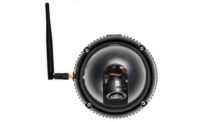Like most everything in enterprise life, there are pluses and minuses.
Many organizations and their security operations want or need wired infrastructure to pull wires upon video expansion or tech upgrading.
Control, security, reliability and speed are among the benefits of using physical connections. The price of cabling – even at the lengths needed to cover a typical office, factory or group of institutional buildings – is relatively inexpensive if you don’t count installation and maintenance labor. “Ethernet requires high quality cable, careful installation and proper termination,” says R. Andrew Bowman, senior project manager at SiteSecure/Miller Electric, a company that specializes in the design, construction and maintenance of IP-based security solutions.
SiteSecure/Miller Electric – also a Verizon Wireless partner for custom uses – is not shying away from the emerging push to wireless.
But, let’s face it, much of security video now works in a hardwired world.
Unshielded twisted pair (UTP), coax, Cat 5, 5e, 6 and 6a are common with legacy, upgraded and new installations, the latter aimed at enterprises more often with IP infrastructure. With known attention to more skilled new installations, fiber optics cabling also is a wired option, especially when fiber already exists. “A cabled connection is much more reliable,” adds Bowman, and “if you have dark fiber (unused to some degree), use it.”
One Choice in the Security Toolbox
No doubt, wireless across the security tool box is making inroads when it comes to access controls, with wireless panels or readers or both, and intrusion detection. The data traffic with these systems is minimal; so for organizations and security, which regularly need to move a lot of video data, a wired set-up is more workable, say many end users, IT colleagues and system integrators. “Wireless, I think, is a mainstream technology now for end users and integrators. Decision makers? IT departments, not the facility folks, not security folks. IT understands this tech,” points out Bowman.
In addition, while a wired infrastructure may be good from a management point of view, having all those wires running throughout a building – i.e., installer labor, trenching and facility accommodations – can be costly and awkward to maintain. Any breaks in the wired connection will have to be manually fixed; there is no software solution to a broken Ethernet pin, for example.
So, with the explosion of mobile devices for physical security monitoring, it’s important that designated “wherever they are” employees have access to the security network, and that means wireless. However, there is caution in the wireless world from a security point of view.
Consider the Security of Video Security
The threat of breaches, malware, viruses and ransomware, among risks, is one particular issue. Mobility also breeds a host of vulnerabilities, although when considering wireless that will extend beyond the hardwired walls of an enterprise, giving attackers another potential route into the business, there is more focus on security of the physical security systems by vendors, integrators, enterprise security executives and their IT partners.
One solution: Physical layer security has recently become an emerging technique to complement and significantly improve the security of communications with wireless. Compared to cryptographic approaches, physical layer security is a fundamentally different paradigm where protection is achieved by exploiting the physical layer properties of systems – thermal noise, interference and the time-varying nature of fading channels, among others.
With so many factors to consider, it’s not surprising that one popular way looking forward is a hybrid of wired and wireless. Still improvements, advances and advantages of wireless make walking that path more attractive.
There are some circumstances, for instance, where wireless security video makes the most business sense – in outdoors when trenching is too expensive or not permitted; at remote, often unmanned facilities; and in environments such as security vehicles and with public transportation applications, to name a few.
A Cost-Effective Option
Hardwired can be expensive, hard to deploy outdoors when trenching is needed and somewhat limiting, but the approach has killer features, says Keith Jentoft, a part of the integration team at Honeywell Security Group, and which just acquired RSI Technologies. Its brand, Videofied, for example, is a wireless solution that can typically include motion detectors, camera, long living battery and cellular modem with a unique SIM card. He hints that streaming may be a future development with his technology.
The sweet spot for some? End users want protection of remote assets and a cost effective option to security officers, he notes.
Still, with some wireless security solutions, transmission speeds may prove slower or less reliable than with some hardwired connections. The continued transition to megapixel, HDTV and high-definition cameras must be addressed in considering wireless, too. Walls and floors, as well as other electronics, can impact the signals. And there is the varying range among wireless points: There can be a limit in how far the signals travel and also can fade the further away from an access point. And more access points drive up the cost of installation.
Advantages of Wireless Communication:
• Maintenance and installation are less costly.
• Security video, thanks to the Internet, can be accessed from anywhere wirelessly.
• Security can monitor certain locations where wired would be impossible or highly expensive, such as construction sites, remote areas and locations that demand temporary installations.
• Ease of integration and convenience.
• Expandability – Wireless networks are capable of serving a suddenly increased number of devices or clients with the existing equipment. In a wired network, additional devices or clients require additional hardwiring.
• Often, a single camera with sentry support can replace more cameras and more expensive solutions, according to Jentoft.
• Wireless technology in general continues to experience both falling prices and increasing acceptance.
Disadvantages of Wireless Communication:
• Wireless can lead to security threats. A constant-frequency signal can be intercepted and not well suited to applications in which information must be kept confidential between the source (transmitting party) and destination (receiving party). It is important to secure the wireless network so that the video information cannot be exploited by unauthorized users. This also increases the risk to “lose” information.
• A signal whose frequency is constant is subject to interference, too. This occurs when another signal is transmitted on, or very near, the frequency of the desired signal. Such interference can be accidental or deliberate.
• Range can be insufficient for some larger structures; and, in order to increase range, repeaters or additional access points have to be purchased.
• The speed on some wireless networks, often older technology, can be slower than the slowest common wired networks.
• Installation of an infrastructure-based wireless network can be complex, calling for a different set of installer skills.
The bottom line: With the challenges of megapixel cameras and streaming video, the quality difference between wired and wireless cameras is, to a growing number of enterprise security executives, less of a determining factor. But image quality isn’t everything. Wired security systems can still provide other advantages that might be critical to security monitoring, storage, retrieval and forensics needs.
Wireless to Fit Specific Locations, Budget and Security Needs
While not every choice fits the bill for security video, when evaluating wireless, there are numerus choices:
IEEE 802.11 Wi-Fi – The wireless local area network or LAN uses radio waves to allow devices to communicate with one another. The technology is most commonly used to connect Internet routers to devices; however, it can be used to connect together any two hardware devices or components. Wi-Fi can reach speeds of some types of wired Ethernet.
Cellular Data Service – It offers coverage within a range of say 10-15 miles from the nearest cell site. Speeds have increased as technologies have evolved, from earlier technologies such as GSM, CDMA and GPRS, to 4G LTE and soon-to-be 5G. For system integrators and end users, there are 4G LTE surveillance kits that permit high-definition wireless cameras to be accessed in real-time and controlled from mobile devices. Live video with minimal latency sends an alert to a mobile device if there is an unwarranted disturbance.
Wireless Mesh – A wireless mesh network is made up of radio nodes organized in a mesh topology. Wireless mesh networks often consist of mesh clients, mesh routers and gateways. A mesh network is reliable and offers redundancy and can self-form and self-heal. But use of wireless mesh calls for maintenance for customers who have it. It can be a complicated solution and not right for every application.
Wireless Mesh Advantages:
• A broken node won’t distract the transmission of data in a mesh network. Each node is connected to several other nodes which makes it easier to relay data. A broken device will be ignored by the signals and will then find a new one that is connected with the node.
• Additional devices in a mesh topology will not affect its network connection. Hence it will improve the traffic in the network. Mesh topology makes a large data center that simulates useful information to its nodes.
• Mesh can handle a high amount of network traffic since every additional device in the network is considered a node. Interconnected devices can simultaneously transfer data smoothly and will not complicate the network connection.
Wireless Mesh Disadvantages:
• Maintaining mesh networks can be challenging to manage but skilled network administrators will find it easy to manage this kind of topology.
• Due to the fact that building this topology welcomes a lot of devices, it will need a lot of capital to invest in. It may be expensive but the service it provides will often be a solid return on investment.
802.11ad – A Qualcomm Wi-Fi chipset scheduled for release this year will power 802.11ad products designed for the wireless office. The IEEE 802.11ad standard is aimed at providing data throughput speeds of up to 7 Gbps. By the way, Gbps stands for billions of bits per second and is a measure of bandwidth on a digital data transmission medium.
But to achieve these speeds, the technology uses the 60 GHz ISM band – the industrial, scientific and medical radio bands reserved for the use of radio frequency (RF) energy for industrial, scientific and medical purposes other than telecommunications. The aim is that it will be used for very short range (across a room) high-volume data transfers such as HD video transfers.
Spread Spectrum Technology – A number of analog video transmission systems have become available for short-range, non-licensed security applications. Because these systems use conventional analog transmission techniques and operate without license, their maximum transmitter output power is limited. The severe range limitation as well as the susceptibility to interference on systems can be overcome by the use of spread spectrum techniques. Unlicensed spread spectrum systems transmit at considerably higher power than conventional narrow band systems.
Satellite – A typical video surveillance solution over satellite is made up of a camera connected to a video encoder via Ethernet or Wi-Fi, normally in an unmanned or semi-manned location. Using a satellite dish and both a receiver and transmitter, the approach is capable of continuous high bandwidth data streams. The camera sends images or a motion video clip to a specified location when it detects motion or other analytics. Typically, this solution only uses uplink from the terminal to send images. Downlink can be used to access the camera from to view live video stream. Remote surveillance solutions usually require a standard IP data connection to transmit still images.
Microwave – Short or long range volumetric microwave links and transceivers aim at open areas, gates, entryways, rooftops and wall applications. There is point to point backhaul and point to multipoint.
Millimeter wave radios – Millimeter waves occupy the frequency spectrum from 30 GHz to 300 GHz. They’re found in the spectrum between microwaves (1 GHz to 30 GHz) and infrared (IR) waves, which is sometimes known as extremely high frequency. At one time this part of the spectrum was essentially unused simply because few if any electronic components could generate or receive millimeter waves. All that has changed. Millimeter waves are now practical and affordable, and they’re finding all sorts of new uses, including security.
A Happy, Hardwired Lagoon Park
When Lagoon Park in Farmington, Utah, closed its gates for the season last November, it was hardly lights out. Instead, it was the start of a major update of the park’s security and surveillance infrastructure to support its goal of migrating to an all IP-based solution. With the challenge of a vast landscape and people and property to protect, the park continues to turn to the advantages of high definition video with the deployment of high resolution cameras.
Security needs have changed. While the initial solution was installed to provide overall park surveillance, it’s now leveraged for overall park management and real-time operations assessment, according to Jon Wright, IT manager/park director, Lagoon Corp. “Originally, the focus of the camera system was strictly from a security standpoint, watching the gates and other areas of the park,” Wright says. “The more we used the cameras, the more we realized that we had a lot of other areas of the business that could benefit from the cameras beyond security applications. We use the cameras more and more for management of employees and their interactions with guests – to watch the mechanics of the roller coasters and overall operations to make sure everything is operating smoothly and safely.”
Surveillance cameras are also used in money sorting areas, in the utility plants to keep tabs on gauges and meters and atop many of the rides to provide an expansive view of the entire property and county for about 15 miles.
Currently, the park has about 600 cameras with 80 percent analog and 20 percent IP, with the analog side to shift increasingly to networked technology over the next few years. Once the park reopened this spring, there were about 1,000 operating cameras. Some 500 existing analog cameras will be converted to network-capable surveillance either with 4K cameras, 360-degree panoramic cameras or with the installation of encoders to convert analog signals to digital. “We don’t have the luxury of tearing everything out at once, so we appreciate the flexibility to upgrade the solution on our timeframe and budget” adds Wright. “I have cameras that have been here more than 25 years, and they are still working well.”





